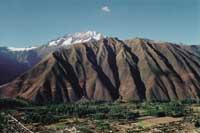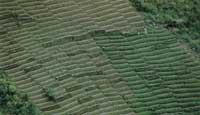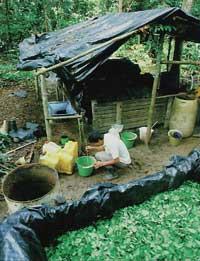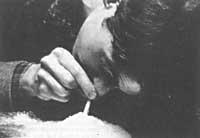Chaccheo
1997/09/01 Laguéns Capablo, María Elena | Rubayo Dominguez, Javier Iturria: Elhuyar aldizkaria
The origin of the custom of chewing the coca leaf is unknown and very old. In the Andean villages it is called chaccheo. That is the sound that would phonetically correspond to castellano3. But it's not just about chewing coca leaves…. The cocaine must be removed! How?
Peruvians say that the simple chewing of vegetable leaves has no influence, so they mix in the mouth with coca saliva and llipta or tocra (a black clay, a mixture of sodium, potassium, aluminum and magnesium silicate), and what they ingest is the juice so produced. In coastal populations, calcium carbonate of marine shells or their powders is used. Colombians chew coca with sodium bicarbonate. In other areas only add sugar.
A farmer knows how to choose the right substance depending on the type of coca leaf, bringing a good juice to the most bitter and fresh. However, the function of clays and collars is not to break the cells indiscriminately, improving the process of homogenization and thus achieving a lighter cocaine. As indicated above, the coca leaves before being treated in the laboratory with diluted acid are macerated in the solution of calcium carbonate. The indigenous people do the same with the chaccheo in their mouth.
It seems that the habit of chewing mushrooms or plants to obtain desired substances is done in many places in the world and in a similar way. In almost all Southeast Pacific, Polynesia, Malaysia and Asia, a narcotic extracted from 4 bitumen is used. Surprisingly, the autochthonous, like the Andean peoples, mix their fruits with the shell powder, the carbonate. In India, the buoy mixture of betel, areca palm, nuts and shell powders is chewed. Although it reddens the lips and saliva, it is used as stimulating and drying.

To cook, the leaves are inserted one after the other in the mouth until a ball is made to which mineral substances are added. The first juice is pulled, unless the recipient has stomach upset, in which case it is swallowed. Gradually a compact paste is formed in the bottom of the mouth and chewed slowly until you get the total juice.
The inside of the mouth loses sensitivity and the tongue is “cumbersome”, it feels like it was swollen by the anaesthetic capacity of the cocaine. The effect lasts for two or three hours depending on the type of coke and some growers have the habit of burning the black cigar.
When the indigenous people get a situation of happiness or climax through coca, they say “I got coca.” According to the anthropologists of the University of Trujillo, the action of chewing the plant is a rite related to the destiny of the human individual. For this reason, the first leaf of the chaccheo leaves with attention, is passed between the teeth, the nervation is removed and the juicy part is left in the mouth. If only the middle nerve comes out, that person will have a “good cheo”, that is, he will be at the door of the happiness of life (he will have work, health, love…). But if you remove the lateral nerves or part of the leaf, it will be a sign of disgrace.
Chaczado emphasizes the importance of leaving coca when it is needed, since not everyone knows how to make the chacchar correctly. All of them, instead of chewing, advise and do kiss the leaves with respect. In this way, they say that the following is the most intense and tasty juice.
Farmers perform three or five stages of chaccheo a day. After the light breakfast, at dawn, the man leaves the ground preparing the first coca drink. Around nine in the morning it takes a new period of chaccheo and restores until it recovers. At noon, eat and take the coca back. He continues to work all afternoon and at sunset he takes a third break while he carries out the fourth coca session. If the work is collective, it will take the fifth season of chaccheo with aguardiente and chicha (corn barley).
The dried leaves are carried in a bag of wool, clay or the nutmeg in a pumpkin, from which they are extracted with a spatula. When you laugh on the Andean shores it is almost impossible not to find white teeth, green lips and men with a coca ball on the cheek. However, the custom of the chaccheo has been mostly male.

Gai honi buruzko eduki gehiago
Elhuyarrek garatutako teknologia





